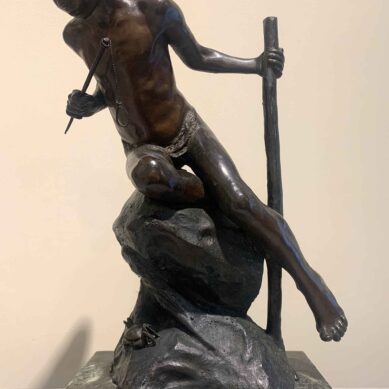You searched
Sculptor
Domenico Jollo
Are you interested in the sales or the purchase of his artworks?
We buy works of this artist
and of other painters and sculptors from the 16th century to the first half of the 20th century
The Berardi gallery offers a free and without obligation service for evaluation of ancient and modern art . To find your way in the art market, very complex and full of nuances, it is better to rely on a professional consultant who can answer fast and concretely to your needs. The clarity of the answers will resolve effectively the need to estimate or sell an asset.
Contact us immediately without commitment
Answers also in 24 hours:
Domenico Jollo
Domenico Jollo
Domenico Jollo was born in Naples in 1866. As a child, he showed an obvious interest in the statues he admired in the streets of Naples. His father, noting this passion and his precocious talent for drawing, enrolled him at a very young age at the Academy of Fine Arts in Naples, where he was initially a pupil of the painters Gioacchino Toma and Antonio Licata. Evidently gifted in modelling, he went under the guidance of Stanislao Lista and Tommaso Solari. But the academic environment did not satisfy him and his intolerance of rules and tradition pushed him towards greater stylistic freedom, which he found in the works of Vincenzo Gemito.
He was therefore expelled from the Academy for a while, only to be readmitted, amidst general protests, to Achille D’Orsi’s course, with whom he finally established an excellent relationship and from whom he graduated in 1890. In the meantime, he had made his debut at the 1888 Promotrice in Naples with the small bronze head Carminuccio, which immediately won him the favour of the critics and the praise of a number of artists, above all Domenico Morelli.
Realist Sculpture
The sale of the work to Count Felix Borchard marked the beginning of the artistic fortunes of the young Domenico Jollo, who quickly conquered the market and the critics, and continued to participate in the Promotrici in Naples: at the 1891 exhibition he showed one of his most successful works, ‘Ncopp’ ‘e scoglie (On the cliffs). But he also took part in several national exhibitions, such as the one in Palermo in 1892, where he exhibited two bronzes, Head of a child and Head of a Boy, which won him a gold medal. In the same year, he was at the Paris Salon with Monello and On the rock, while at the National Exhibition in Rome the following year, he presented Luigiello.
Domenico Jollo’s spontaneous and poetic naturalism emerges from these works, all characterised by an expressive flicker and a feeling of instinctive participation, which is particularly noticeable in the works denoted by a certain socio-humanitarian interest. A perfect example of this tendency is The Meal, exhibited at Brera in 1894 and dedicated to the figure of a stone breaker who stops to eat and who arouses in the viewer a sense of compassion for his modest condition as a worker, bent by fatigue and holding only a meagre piece of bread.
The 20th century: between realism and Art Nouveau
In 1897, Domenico Jollo exhibited Frammento at the Venice Biennale, while Miseria appeared at the Munich Exhibition the same year. Sorrow was awarded a prize in Barcelona in 1898 and, together with the two previous sculptures, marked the beginning of a new trend, in which the modelling, still in the verista style, was imbued with a spiritual and symbolic inspiration, which was definitively manifested in Dolores (1904) and Drowned (1907).
In the meantime, he won the competition for the chair of Sculpture at the Academy of Fine Arts in Urbino and devoted himself to a series of monuments, such as The Genius that crowns the Fine Arts for the frontispiece of the Mercadante Theatre in Cerignola (Puglia), the city for which he also executed the Bust of Garibaldi in 1909. A decidedly more solemn and Art Nouveau declination characterises these public works and also denotes some portraits painted in his maturity, such as the Bust of Giuseppe Caputi. In the Tombstone to the deaths in war of Cerignola of 1923, there is a classicist tension and a monumental plasticism that distances him from his first spontaneously verist expressions, which seem to resurface in the Miner exhibited in Turin in 1931. Active until the end, he died in Naples in 1938.
Elena Lago







